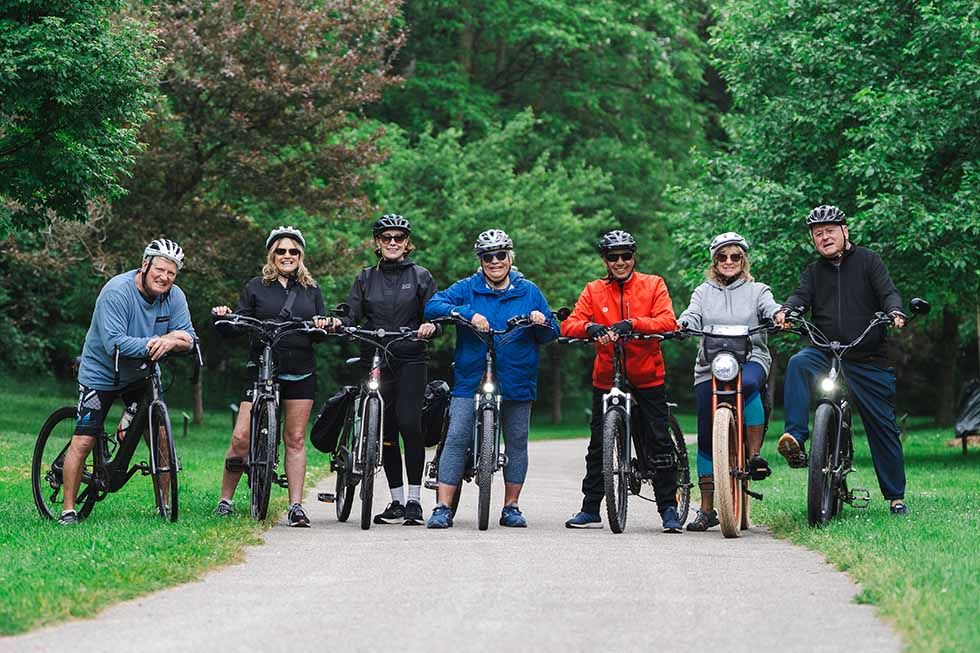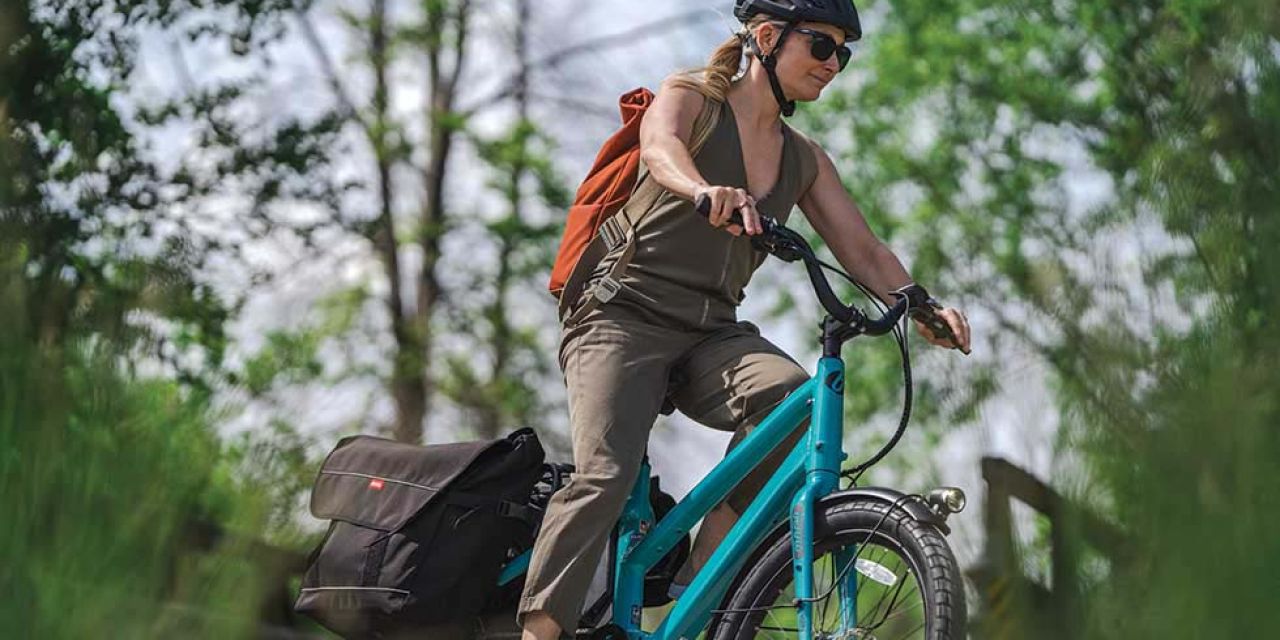Nicole Kertcher runs errands in Collingwood on her cargo e-bike.
Electric Avenue
by Robin Todd | photography by Jody Wilson
For those of us simply looking for a way to get around town safely, comfortably, and quickly, electric bikes make the sport more accessible, exhilarating, and fun. From avid cyclists to everyday commuters, more cyclists are embracing this e-volution.
Despite being an avid cyclist and experienced bikepacker, I confess I had very limited knowledge of electric bicycles (e-bikes) until recently. It was only as I prepared to write this article that I came to learn how diverse the world of e-bikes is and how much potential they have to transform the riding experience for all cyclists.
For Justin Jones, a strong advocate for pedestrian-friendly communities, his cargo bike is central to his way of life, using it for everything: taking his kids to school, picking up groceries, and exploring the neighbourhood. When he put an electric kit on the bike seven years ago, it “completely transformed” his relationship with the bike. The electric assist made the 135-pound bike as easy to ride as his road bike, thus opening up the possibilities for its usage. Jones talked about how special it is to have his kids close to him as he cycles through the neighbourhood; his kids sit right in front of him, and they can observe things together. Jones also suggested that cycling through a community makes you a part of it; it “creates social cohesion that you can’t duplicate in cars.” Jones summed up his e-bike as an “investment in joy.” Clearly, Jones is not alone in making such an investment.
Summit Social House in Collingwood has become a hub for the local cycling community. Owner Bruce Zigman has noticed a growing interest among customers in purchasing cargo e-bikes as an alternative to owning a second car—they see these bikes as a means to reduce their environmental impact and save money. Kris Baumgarten, owner of Kamikaze Bikes, agreed. He seen increasing demand for utility e-bikes as riders seek to increase their riding habits and decrease their carbon footprint. Rather than going for a ride and then getting into the car to run errands, an expanding number of riders are now combining their activities, getting exercise while they complete their errands. The e-bike makes such a blending of activities much more feasible and enjoyable, especially in Collingwood, where every neighbourhood is connected to the trail system.
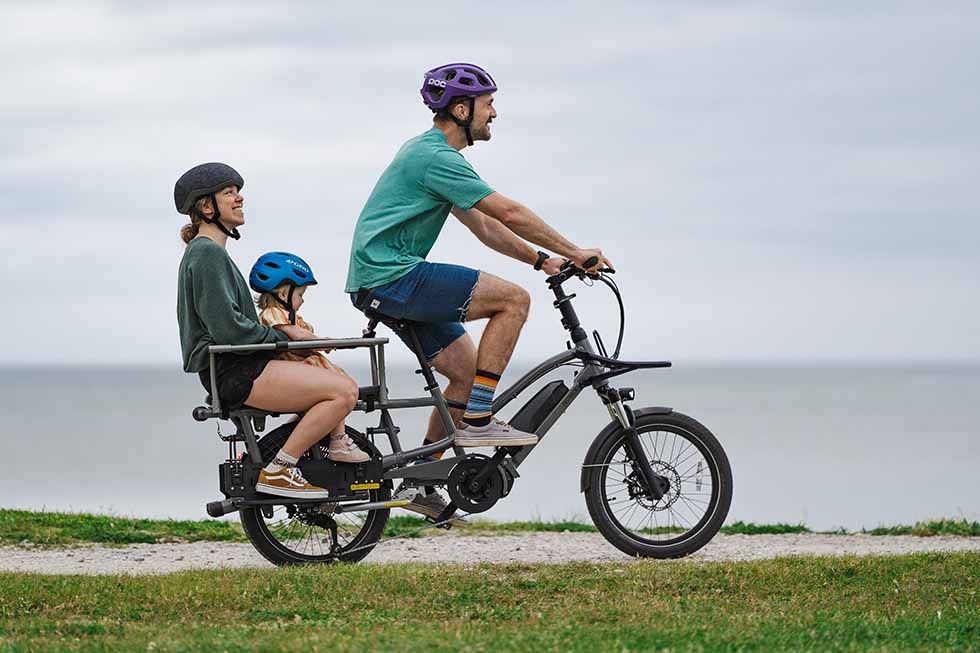
The Bond/Bennett Family, Kelsey, Casey & Jesse enjoy an afternoon ride by the water.
Also gaining in popularity are pedal-assist road bikes, as they extend how far and how fast riders can go, thus allowing them to remain in their cycling groups as they age or even to rejoin groups they had ridden with in the past. Bill Furse, a seasoned rider and member of the Collingwood Cycling Club, can remember exactly when he decided to invest in a pedal-assist road bike. Two years ago, while out riding with a group in Florida, he found he was getting left behind by riders he had ridden with for years. He tried riding with a female group of riders instead, and they dropped him too, for the same reason: they had all invested in e-bikes. Furse recalls that he rode home and told his wife he needed to get an e-bike. He now rides a Specialized Creo SL, which he finds most valuable when climbing hills. When his heart rate gets close to maximum, he will switch into assist or increase the level of assist until his rate comes back down. As Furse said, the assist “gets you over the hilly parts without killing yourself.” In reflecting on the benefits of his e-bike, he emphasized that he is still working hard, but the assist allows him to work hard for longer and to continue to keep up with his riding group even at 81 years of age!
Similar to Furse, at 69 years of age, Collingwood resident Sharon Chadwick decided to buy a pedal-assist road bike to ensure that she could continue to do the kind of cycling she loved, including taking part in a fundraiser for pancreatic cancer that requires riding up to 100 miles a day for seven days straight. This year, in her tenth year of taking part, she completed 971 kilometres with over 8,000 meters of climbing on her brand-new Pinarello Nytro Urbanist. She was concerned the battery might not last on the longer days, but on their biggest day of 171 km, she still had 20% battery remaining at the end. Weighing in at 17.44 kg, the bike took some time to get used to, Chadwick noted, especially when climbing. Going forward, Chadwick says she will continue to use her beloved Cannondale pedal bike when riding with the group, but she will be inclined to use the pedal-assist bike when heading out with faster riders.
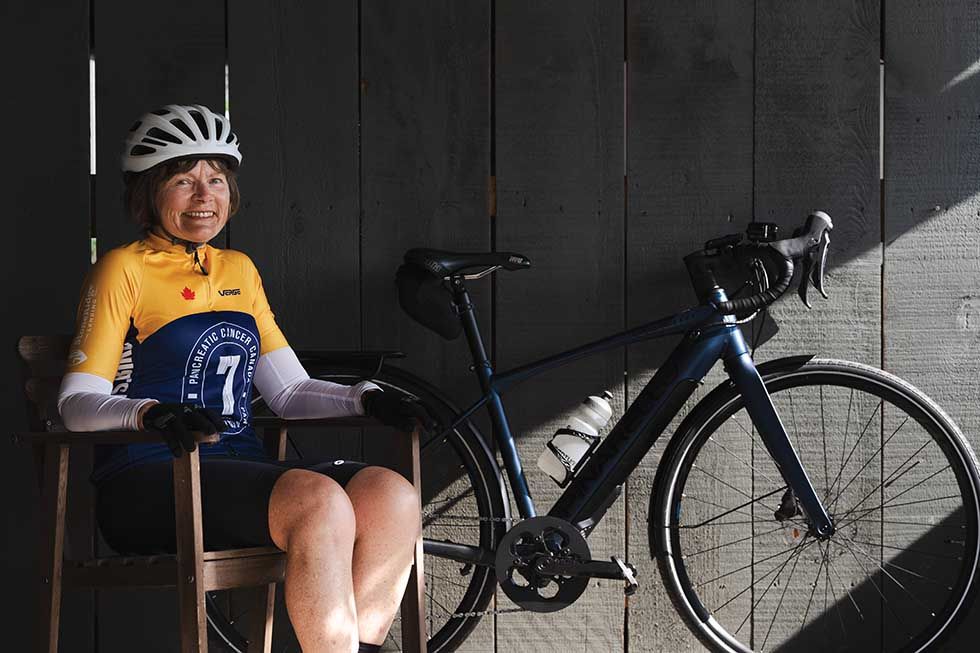
Sharon Chadwick, after completing a 971 km, 7 day ride on her new electric road bike.
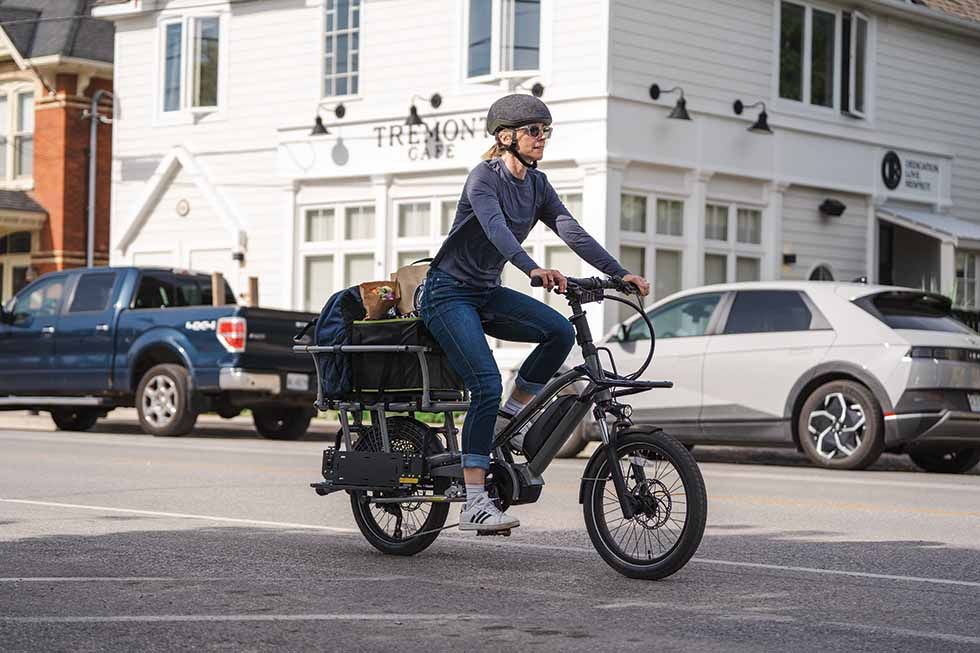
Laura Wilson enjoying a Saturday morning trip to the Collingwood farmers market on a cargo e-bike.
Just as the demand for pedal-assist road bikes is increasing, so is the demand for pedal-assist mountain bikes. Baumgarten explained that they allow riders to climb at lower heart rates, thus enabling them to experience a good workout while also riding twice as long. When it comes to downhill riding, shuttling the heavier, longer-travel bikes by vehicle to the top of a climb has always been a big part of the process. With e-bikes, the need for shuttling is eliminated, and thus the activity’s carbon footprint is reduced. Perhaps not surprisingly, the sale of e-bikes has risen exponentially since the store first started selling them ten years ago. Baumgarten estimates that 25% of their sales now come from e-bikes, 99% of which are pedal-assist bikes and 1% of which are throttle-control bikes, which do not require pedalling.
E-bikes have gained great popularity in groups such as the Lighthouse Probus Club, where the objective is to combine social and recreational activities for people with common interests. Ed Cohen, who leads group rides for the club, said within the group, some ride pedal bikes, and others ride e-bikes. He invested in an Aventon Soltera e-bike, with the goal of using the battery as little as possible. Cohen emphasized the need for both fitness and bike handling skills when dealing with the weight that the electric battery adds to the e-bikes. In fact, he has helped a number of members of the group learn how to start and stop safely, which is when the bike’s weight can prove challenging. For the group, the e-bikes allow riders with a wide range of fitness levels to enjoy trips, such as their regular ride from Thornbury to Meaford and back, with the peace of mind that comes with the added assistance of the electric battery.
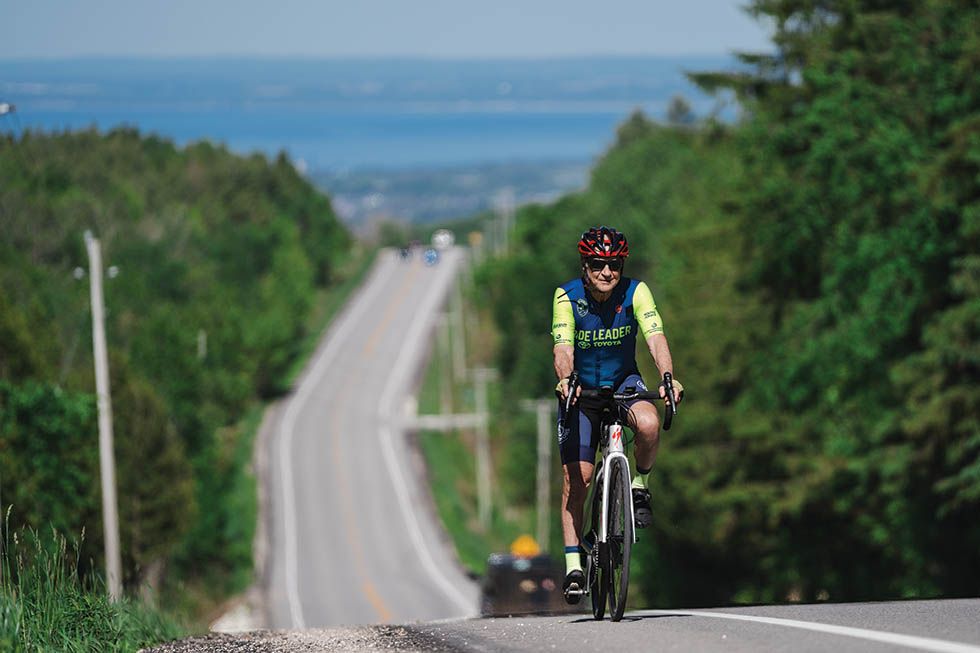
Bill Furse makes his way up the 7 km climb on Grey Road 19.
The extent to which riders wish to rely on the electric assist is as varied as the riders. Ellen Herbert and her husband, John, had been cycling enthusiasts in the past, but their most recently purchased pedal bikes had sat in the garage unused. She decided to buy two Urban Ryder e-bikes. Though her husband was not keen at first, he took one ride around the block and was hooked. Since then, they have sold their pedal bikes and now ride their e-bikes exclusively. Though both are athletic and active, Ellen Herbert said when they ride, “they are content to be tourists and to let the bikes do the work.” Riding with their Probus group, most of whom have e-bikes, they can go as far as 50 km on a single battery charge, allowing them to venture to neighbouring communities such as Wasaga Beach and Stayner, all on the extensive Georgian Bay trail system. Herbert called the e-bikes a “game changer” that has led to making all sorts of wonderful social connections.
Clearly, the electric bike extends the possibilities for people to embrace the joy of riding and to incorporate riding into their lives more fully. Though people may differ widely in the kind of electric bike they choose to ride, what they share is the sense of fun and freedom that comes from moving through the world on two wheels, perhaps for the first time in their lives. Is there an e-bike in this bikepacker’s future? Absolutely. E
